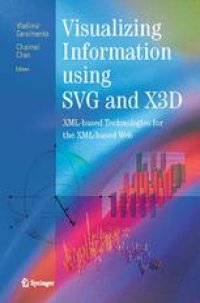
Ebook: Visualizing Information Using SVG and X3D
- Tags: User Interfaces and Human Computer Interaction, Multimedia Information Systems, Computer Graphics, Information Systems Applications (incl.Internet), Pattern Recognition
- Year: 2005
- Publisher: Springer-Verlag London
- Edition: 1
- Language: English
- pdf
Correcting the Great Mistake People often mistake one thing for another. That’s human nature. However, one would expect the leaders in a particular ?eld of endeavour to have superior ab- ities to discriminate among the developments within that ?eld. That is why it is so perplexing that the technology elite – supposedly savvy folk such as software developers, marketers and businessmen – have continually mistaken Web-based graphics for something it is not. The ?rst great graphics technology for the Web,VRML,has been mistaken for something else since its inception. Viewed variously as a game system,a format for architectural walkthroughs,a platform for multi-user chat and an augmentation of reality,VRML may qualify as the least understood invention in the history of inf- mation technology. Perhaps it is so because when VRML was originally introduced it was touted as a tool for putting the shopping malls of the world online,at once prosaic and horrifyingly mundane to those of us who were developing it. Perhaps those ?rst two initials,“VR”,created expectations of sprawling,photorealistic f- tasy landscapes for exploration and play across the Web. Or perhaps the magnitude of the invention was simply too great to be understood at the time by the many, ironically even by those spending the money to underwrite its development. Regardless of the reasons,VRML suffered in the mainstream as it was twisted to meet unintended ends and stretched far beyond its limitations.
This is the first book devoted to both SVG and X3D as a new and universal means of visualizing information. It presents the state-of-the-art research emerging in this novel area and introduces SVG and X3D fundamentals and leading authoring tools. The key topics covered include: - The foundations of SVG and X3D - Data, information, knowledge and network visualization - Advanced and distributed user interfaces - Visualizing metadata and the Semantic Web - Visual interfaces to Web services - New trends and paradigms in publishing and Interactive TV - Displaying geographically referenced data and chemical structures - Advanced use of Adobe Illustrator and X3D-Edit authoring tools This book will be essential reading not only for researchers, Web developers and graduate students but also for undergraduates and everyone who is interested in using the next-generation computer graphics on their websites.
This is the first book devoted to both SVG and X3D as a new and universal means of visualizing information. It presents the state-of-the-art research emerging in this novel area and introduces SVG and X3D fundamentals and leading authoring tools. The key topics covered include: - The foundations of SVG and X3D - Data, information, knowledge and network visualization - Advanced and distributed user interfaces - Visualizing metadata and the Semantic Web - Visual interfaces to Web services - New trends and paradigms in publishing and Interactive TV - Displaying geographically referenced data and chemical structures - Advanced use of Adobe Illustrator and X3D-Edit authoring tools This book will be essential reading not only for researchers, Web developers and graduate students but also for undergraduates and everyone who is interested in using the next-generation computer graphics on their websites.
Content:
Front Matter....Pages i-xiv
SVG and X3D in the Context of the XML Family and the Semantic Web....Pages 3-20
The Foundations of SVG....Pages 21-62
X3D Fundamentals....Pages 63-84
SVG as the Visual Interface to Web Services....Pages 85-98
X3D Graphics, Java and the Semantic Web....Pages 99-118
Distributed User Interfaces: Toward SVG 1.2....Pages 119-152
Publishing Paradigms for X3D....Pages 153-180
Visualizing Complex Networks....Pages 183-201
Applying SVG to Visualization of Chemical Structures and Reactions....Pages 202-224
Using Metadata-based SVG and X3D Graphics in Interactive TV....Pages 225-244
Knowledge Visualization Using Dynamic SVG Charts....Pages 245-255
Using SVG and XSLT to Display Visually Geo-referenced XML....Pages 256-265
Using Adobe Illustrator to Create Complex SVG Illustrations....Pages 266-284
X3D-Edit Authoring Tool for Extensible 3D (X3D) Graphics....Pages 285-292
Concluding Remarks Vladimir Geroimenko and Chaomei Chen....Pages 293-294
Back Matter....Pages 295-298
This is the first book devoted to both SVG and X3D as a new and universal means of visualizing information. It presents the state-of-the-art research emerging in this novel area and introduces SVG and X3D fundamentals and leading authoring tools. The key topics covered include: - The foundations of SVG and X3D - Data, information, knowledge and network visualization - Advanced and distributed user interfaces - Visualizing metadata and the Semantic Web - Visual interfaces to Web services - New trends and paradigms in publishing and Interactive TV - Displaying geographically referenced data and chemical structures - Advanced use of Adobe Illustrator and X3D-Edit authoring tools This book will be essential reading not only for researchers, Web developers and graduate students but also for undergraduates and everyone who is interested in using the next-generation computer graphics on their websites.
Content:
Front Matter....Pages i-xiv
SVG and X3D in the Context of the XML Family and the Semantic Web....Pages 3-20
The Foundations of SVG....Pages 21-62
X3D Fundamentals....Pages 63-84
SVG as the Visual Interface to Web Services....Pages 85-98
X3D Graphics, Java and the Semantic Web....Pages 99-118
Distributed User Interfaces: Toward SVG 1.2....Pages 119-152
Publishing Paradigms for X3D....Pages 153-180
Visualizing Complex Networks....Pages 183-201
Applying SVG to Visualization of Chemical Structures and Reactions....Pages 202-224
Using Metadata-based SVG and X3D Graphics in Interactive TV....Pages 225-244
Knowledge Visualization Using Dynamic SVG Charts....Pages 245-255
Using SVG and XSLT to Display Visually Geo-referenced XML....Pages 256-265
Using Adobe Illustrator to Create Complex SVG Illustrations....Pages 266-284
X3D-Edit Authoring Tool for Extensible 3D (X3D) Graphics....Pages 285-292
Concluding Remarks Vladimir Geroimenko and Chaomei Chen....Pages 293-294
Back Matter....Pages 295-298
....


















